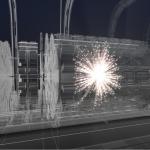Paper of the month: Future Circular Collider - What the future might hold for High Energy Physics

February 22, 2019 by Bruno Martin
The future of particle physics was placed in the international spotlight last month, with CERN releasing its study into a next-generation particle accelerator, the Future Circular Collider (FCC) [1]. With a 100km circumference, 50 year run-time and 30 billion CHF price-tag, the proposed machine would combine state-of-the-art experimental physics, electrical engineering, information technology and material science. If built, this remarkable experiment would shape the direction of particle physics research for the next 50 years and beyond.
CERN outlined a double-pronged programme for the FCC. It would firstly collide electrons and positrons (anti-electrons) as the FCC-ee, just like the famous LEP experiment of the 1990s but with tremendously improved intensity. This run expects to produce five trillion Z bosons, almost a million times the number detected at LEP. It would allow many extremely precise tests of the Standard Model. The second half of the FCC’s existence, as FCC-hh, would be dedicated to smashing together protons, the same process as the LHC but at energies seven times higher. This may enable the production of hitherto unseen particle which are too heavy to make in current experiments. A third prong, FCC-eh, has also been slated. It would collide electrons and protons together, which has previously been done only at the HERA experiment. Among the many revelations this could bring is an unparalleled insight into the precise structure of the proton, one of the building blocks of matter.
Aerial view showing the current ring of the LHC (27km) and the proposed new 100km tunnel that could host different colliders modes (FCC-ee, FCC-hh, FCC-he). [CERN, http://cds.cern.ch/record/2653532]
Precision measurements have the potential to probe particles that are much heavier than the energy scale accessible at colliders. Similar studies have already been very important in the past to build the Standard Model. Typical examples are the discovery of charm and bottom quarks from indirect observations at low-energies years before the direct production of these particles in colliders. Likewise, the LEP experiment was crucial for determining the masses of the top quark and Higgs boson via precision measurements, guiding the direct searches at Tevatron (Fermilab) and LHC (CERN), where these particles were respectively discovered in 1995 and 2012. The FCC-ee plans to significantly improve the Standard Model measurements in both the flavour and electroweak sectors, with an unprecedented potential to unveil deviations from the predicted Standard Model behavior.
Apart from testing Standard Model interactions, the FCC-hh aims to search directly for evidence of new, unknown ones. Accelerating, and then colliding, protons at higher energies than any collider before it could enable the production of particles that are too heavy for modern-day experiments. Perhaps the most elusive hypothetical particle is dark matter (DM), and the FCC intends to make a significant development, in particular by comprehensively searching for DM candidates known as weakly interacting massive particles (WIMPs) which might interact with some of the known microscopic forces of nature in a simple way. Such models may be more attractive to theorists than positing new microscopic forces. At the same time, among many other searches, the FCC should be able to discover or definitively rule out heavy particles which could enable an efficient electroweak baryogenesis, a scenario where the Higgs boson plays a crucial role in explaining why there is more matter in our Universe than anti-matter (and hence why we exist!). Such a tantalising possibility is currently disfavoured but has not yet been dismissed--the FCC would have the final say.
Artistic impression of a collision event at the centre of a future detector following preliminary design studies. [CERN, http://cds.cern.ch/record/2653532]
Building a future collider is not only important to fulfil our curiosity about nature. The construction of such an ambitious project would require the development of high-tech industries, leading to products and services that can be useful to our society, as we have already witnessed at the LHC and its predecessors. Concrete examples are the invention of the World Wide Web (WWW) at CERN in 1989 [2], as well as the innovative use of CERN technology for cancer treatment [3].
The FCC conceptual design report [4] is part of the next update of European Strategy for Particle Physics, which will have its symposium in Granada in May this year [5]. Alternatives to the FCC project are the Compact Linear Collider (CLIC) and the International Linear Collider (ILC), both of which rely on complementary technologies and would have a different capacity to discover new phenomena. A decision from the European Union is expected in the coming years, guiding the direction of the particle physics in the post-LHC era. The entire research community waits with bated breath for the outcome.
Rupert Coy (CNRS) and Olcyr Sumensari (INFN)
References
[1] M. Benedikt et al., Future Circular Collider - European Strategy Update Documents, http://cds.cern.ch/record/2653673
[2] https://home.cern/science/computing/birth-web
[3] https://kt.cern/article/using-cern-magnet-technology-innovative-cancer-treatment
[4] http://fcc-cdr.web.cern.ch
[5] https://europeanstrategyupdate.web.cern.ch/


